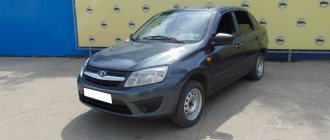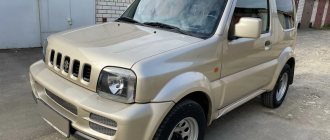Sales of Lada Vesta began in 2015. Currently, this model can be found more and more often on the used car market. Experts from various online publications decided to compare a used Lada Vesta with its closest competitors in the same price segment (about 500 thousand rubles) in order to understand what the buyer of a three-year-old AVTOVAZ car will face.
Content
- Fact #1. Good handling
- Fact against #1. Poor quality suspension parts
- Fact #2. Large ground clearance
- Fact against #2. Windage on the track
- Fact number 3. Spacious salon
- Fact against #3. Poor quality interior assembly
- Fact number 4. Rich configurations
- Fact against #4. Poor quality options
- Fact #5. Competitive price
- Fact against #5. Inferior in comfort to foreign cars
- What problems can you encounter on the secondary market?
Fact against #1. Poor quality suspension parts
Having improved the suspension, the manufacturer did not take care of the constantly squeaking bushings. Owners have to modify and lubricate them themselves.
The suspension is hard. When driving over uneven surfaces, various noises occur. If there are passengers sitting in the back, the struts can break through bumps. Those who change from earlier VAZ models immediately notice this.
When the brake pads wear out, the calipers begin to tap even halfway. Installing new pads or “makeshift” pressure springs helps solve the problem.
Also read: Which suspension is better: soft or hard
A number of changes
It can be noted that AvtoVAZ designers introduced a number of changes to their new creation:
- The power plant on this car is mounted on a subframe.
- The steering rack dropped a little lower.
- The ends themselves are attached directly to the steering knuckle, rather than through the strut, as on earlier cars.
As a result, feedback has noticeably improved, and car control has become sharper. In practice, this manifests itself as follows: even with a slight turn of the steering wheel, the trajectory of the car changes instantly.
Fact against #3. Poor quality interior assembly
The whole “raspberry” is spoiled by the constant creaking of the front panel and other plastic parts. The driver himself has to look for the source of the annoying sound and add an anti-creak.
The plastic parts do not fit tightly. Due to the gaps between them and the body, extraneous sounds occur. In addition, the plastic itself looks cheap, and its texture is unpleasant to the touch.
Also read: All Russian cars are bad: truth or stereotype
Fact number 4. Rich configurations
Vesta is equipped with the latest technology. In the “fattest” trim levels you can find:
- four airbags;
- rain and light sensor;
- ERA-Glonass system (assistance in emergency situations);
- active safety systems: ABS, BAS, EBD, ESC, TCS, HSA;
- climate control;
- multimedia with navigation;
- leather interior.
This Vesta is a worthy competitor to budget foreign cars such as Kia Rio and Hyundai Solaris.
Let's sum it up
To finally decide whether to buy the popular new LadaVesta, you need to find out about discounts and other possible favorable conditions for purchasing a car. Now almost every dealership offers every client a low-interest credit purchase system.
If, when asked whether it’s worth taking this car, you answered positively, but you don’t want to get involved with loans, then you can save a decent amount if you buy Vesta second-hand. It will not be difficult for you to find a used car in good condition at an affordable price.
Fact against #4. Poor quality options
The poor execution of some options is disappointing. There is no indication of any kind indicating the activation of the traction control or stabilization system. Therefore, the driver may not notice that the car is “carrying.”
There should be an indication on the stabilization deactivation button itself, but it does not work. Therefore, you never know whether ESP is turned on or, conversely, turned off. It seems like a small thing, but it’s unpleasant.
The rain sensor does not work well and does not work at the right time even at maximum sensitivity.
The quality of the eco-leather interior leaves much to be desired. The seats wear out quickly, and the material is susceptible to scratches even with the slightest impact of a hard object.
Also read: Which is better: Granta or Kalina 2?
Maintainability and warranty
For example, there was a whole presentation about what a wonderful pump was being installed. It is foreign, will not break, and will last longer than the car itself. But the miracle does not happen - it breaks, like everything else in our world. Only the cost of replacement is foreign-made, not Zhiguli.
The attachment rollers also caused problems. They came from the factory without lubrication, then jammed, and this had serious consequences, including replacing the motor. Now official dealers have orders to inspect these rollers and preventative replacement.
Official dealers provide replacement under warranty - no one has used these words about the Lada before. Now they even provide replacement cars and personal managers! Now this car can not only be manipulated somewhere in garages - it is serviced by an official dealer.
From the point of view of the second owner, this is an absolute plus. You can expect to receive a car with a transparent ownership and maintenance history. The service book and documents will be filled out on it. You will understand what the mileage is and what happened during it.
Fact #5. Competitive price
The average price tag of Vesta on Avto.ru is 561 thousand rubles. For this money you get a fresh car from 2016, with a multimedia system, multi-steering wheel and leather/Alcantara interior:
The closest competitor - KIA Rio in a similar configuration costs from 600 thousand:
The new Vesta 2022 in the Comfort package with multimedia, 1.6 liters and “robot” will cost 680,000 rubles.
Lada Vesta: Is it worth buying a three-year-old sedan for 500 thousand rubles
Lada Vesta is a long-awaited revolution in the life of AvtoVAZ, and indeed the entire Russian automobile industry. The first Russian car for which there is no shame, which buyers chose for its attractive design and which was not much inferior in characteristics to its classmate foreign cars. At the same time, Vesta, of course, no longer cost a penny, but was noticeably cheaper than the foreign leaders in the segment, which ultimately brought the model to the top of the sales statistics.
True, it should not be denied that the economic crisis with the falling purchasing power of the population also helped the model in this matter. It was not uncommon to hear in Lada showrooms that the Vesta was a forced and temporary purchase, and as soon as the income situation improved, it would definitely be replaced with a foreign car.
One way or another, the first owners of Vesta now value their purchase - the cost of three-year-old copies cannot be called junk. You won’t find 2015 cars cheaper than 400,000 rubles, and on average, offers, including 2016 options, range from 450,000 to 550,000 rubles, without much dependence on the configuration. The new Lada Vesta today costs from 600,000 rubles for the “base” and from 650,000 rubles for a complete set with air conditioning.
If we talk about the reliability of the Lada Vesta as a whole, then this factor was greatly influenced by the massive use of imported components, which the car received as part of the integration of AvtoVAZ into the Renault-Nissan alliance. In fact, calling Vesta a domestic car can be quite arbitrary, since it does not have a single component or system that does not use foreign components.
Engine
At the beginning of its production, Lada Vesta was equipped with a single 1.6 engine with 106 horsepower. This is a modified VAZ unit of the 21129 series, which dates back to the days of the Priora. The entire piston group for the engine is supplied by the American company Federal Mogul, and the engine itself is adapted to use a French gearbox from Renault.
An engine with a timing belt mechanism is generally recognized as quite reliable even by the standards of foreign cars, and its performance is very good. However, as always, there are certain operating nuances.
First of all, an engine made according to imported standards and meeting all modern Euro-5 environmental standards requires very high-quality oil and fuel, otherwise problems with these two systems may begin.
An indicator of the onset of problems with the fuel system is increased gasoline consumption, which may be associated with a malfunction of the injectors, fuel pump or catalyst. Another identified problem with Vesta is engine adjustment, or even an unexpected refusal to start. The clear reason is not completely clear, so some servicemen blame the same gasoline, while others blame the motor electrics or software. The last factor takes place, since the Vesta engine is literally wrapped in wires - there are about 50 different connectors under the hood, so it’s no wonder that over time the electrics and all kinds of sensors can “glitch”.
It’s difficult with routine maintenance. An imported heater radiator may leak, which only comes complete with the entire installation and requires complex disassembly, fortunately there are already cheaper analogues. The engine is generally very tightly clamped in the engine compartment, so replacing the timing belt and rollers requires disassembling half of the right side of the car. And if you need to remove the pan, you will have to first dismantle the gearbox. All this leads to almost foreign-made service prices: scheduled maintenance with an oil change approaches 10,000 rubles, and together with the replacement of operating fluids and the generator (drive belt) - to 20,000 rubles.
Transmission
Lada Vesta is still equipped with two gearboxes: mechanical and robotic.
There are two types of manual transmission on the Vesta. From the moment of production, the French JH3 transmission from Renault is installed on the car. The domestic box was then personally rejected by Bo Andersson due to its noise and poor selectivity. However, since October 2016, Vesta received a Russian modified gearbox 21807 with a cable drive, which is still installed to this day. It is difficult to distinguish the boxes by external features, but you can easily determine them by the VIN number: code GFL13 means French unit, GFL11 means Russian.
On French “mechanics” with high mileage, the secondary shaft bearing will most likely have to be changed and, sometimes, the first gears are difficult to engage due to the locking mechanism of the shift rod. The problem is the poor casting of the gearbox housing, which is produced at AvtoVAZ. The domestic one, in a word, is still annoying only with its innate howls.
The second gearbox is robotic, which AvtoVAZ positioned as an analogue of an automatic transmission. Of course, a primitive “robot” with one clutch is far from the comfortable behavior of a classic hydromechanical gearbox, so the demand for such versions of Vesta still does not exceed 10%.
Technically, the AMT transmission is the same domestic manual 2180, only with automatic clutch release and gear shifting, for which ZF actuators are responsible. There are no special issues with the gearbox regarding the hardware, but the electronic control unit regularly malfunctioned, which is why the already not very comfortable transmission regularly became “stupid”, confused and delayed in shifts. It can be treated by reflashing it, but it does not get rid of the behavior of the “robot”. AvtoVAZ still refuses to install a full-fledged automatic transmission on the Vesta for financial reasons, although there are test copies with the Jatco variator from Nissan.
Suspension and brakes
One of the main advantages of the Lada Vesta is its well-tuned suspension, which allows the car to listen well to the steering wheel and drive well over our potholes. Unfortunately, this does not eliminate technical problems. Almost all the rubber connections in the suspension parts turned out to be weak and at the same time rigid, so that even the almost new Vesta tapped and creaked like a cart. Nowadays, better quality rubber products are used.
In particular, the knocking of the stabilizer struts and the play of the ball joints are a universal problem for the “West” of the first releases. The front spring supports rub against the housing of the support bearings, the stabilizer bushings creak, and the silent blocks of the rear beam quickly wear out. The rear “Saaz” shock absorbers also don’t last very long, and may require replacement up to 50,000 km.
The brake system does not cause any particular problems (except for increased wear of the pads, which may not be enough for 15,000 km). The discs last about 100,000 km.
Body and interior
In general, the very stylish body of the Lada Vesta by British designer Steve Mattin is still holding up well. Without damage to the paint down to the metal, the body resists corrosion, however, under the bottom of the car, a huge number of technological joints, connections and holes were found that were not exposed to the factory anticorrosive and which are already covered with rust. In another three to five years, these places are guaranteed to become hotbeds of corrosion. Paint does not adhere well to plastic body parts, in particular bumpers.
Alas, the absence of major body flaws is compensated by an abundance of small but annoying defects. Due to the very tight seals within the doors of the Vesta, the side windows are scratched. Frankly bad standard wipers also scratched the windshield. The hood seals and door limit switches are coming off, their opening handles are jammed, the window heating is failing, and the turn signals are sweating.
Not everything is smooth inside either. Crickets, bugs and rattles are, one might say, familiar to a domestic car. In addition, door panel trims may begin to come off, not to mention all sorts of decorative little things like speaker grilles. Well, and most importantly - the constant glitches of the standard multimedia system, which even a new one could have stripes of dead pixels.
Conclusion
Generally speaking, over three years no serious problems have arisen with the Lada Vesta, and if you consider that the first cars just came out of the factory warranty and a lot of things in the cars were changed as part of the recall campaigns, then the car can be considered quite reliable.
Most of the problems with Vesta are, alas, associated with some not-so-high-quality domestic components, Russian assembly, and the structural “crudeness” of the first copies. For 400-500 thousand rubles - these are offensive shortcomings that may not allow the new owner to relax, unless you stumble upon a caring owner who has corrected a lot on his own.
Well, besides, AvtoVAZ is constantly in the process of modernizing its main model, and a lot has already been corrected in the new Vesta. So, to be honest, the difference between two and three-year-old models in financial terms is not so serious as to refuse to buy a new car. In the end, monthly expenses for maintenance and modifications to a used Vesta can be quite comparable to loan payments for a new car.
We would wait until prices for a used new Lada drop to the three hundred thousand mark.
Fact against #5. Inferior in comfort to foreign cars
Some buyers prefer to overpay 50 thousand rubles and get a foreign car. Or they choose older models, but from famous brands. For 550 thousand rubles you can buy, for example, a Toyota Camry VI (XV40) 2006-2008 with a leather interior:
Or Mazda 6 II (GH) 2008:
Also with a leather interior, multimedia and a more powerful engine than the Vesta.
Such cars will certainly be a good alternative to almost new Vestas. They are better in technical characteristics and comfort level. They will only be 8-9 years older.
Also read: 10 most reliable cars
Robot AMT
Another reason to be upset is the AMT robot. This is not an automatic machine that many car users would like to see, but a rather thoughtful “robot”. Which in addition also has a whole list of disadvantages:
- “jerking” when changing gears;
- long acceleration to 100 km/h;
- You shouldn’t count on it in difficult situations either: it’s hard to start uphill, in traffic jams, in order to move forward just a few centimeters, you’ll have to be patient. These shortcomings are caused by the very smooth closing of the clutch. However, even with this approach, the clutch on Vesta is a consumable. Some “lucky ones” manage to change it more than once before the end of the warranty period.
It is also worth noting that almost all of Vesta’s foreign colleagues have long since experimentally abandoned such a transmission. But others are not an example for us. The domestic manufacturer tried to become a pioneer in this matter.
As it turned out, this model has many shortcomings and all of them are quite serious. The good news is that they are not present on all cars. But after paying a pretty tidy sum for a car, you want to get something more than a pig in a poke.
- Author: Alexey Vinokurov
Rate this article:
- 5
- 4
- 3
- 2
- 1
(38 votes, average: 2.4 out of 5)
Share with your friends!











